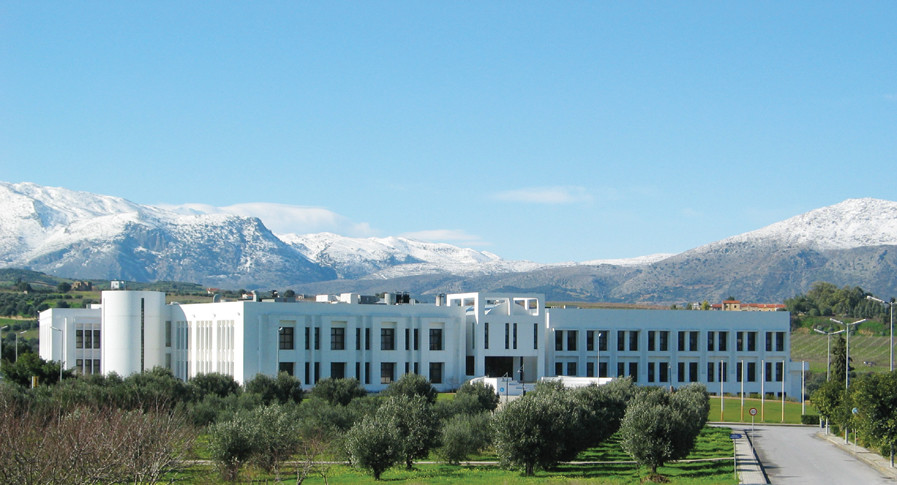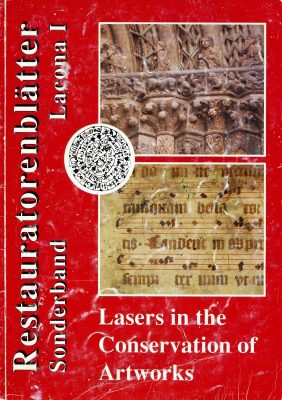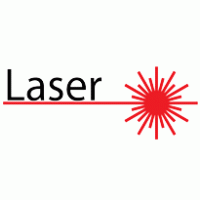4-6 October 1995
LaCONA IHeraklion, Greece
Workshop: Lasers in the Conservation of Artworks

Date
4-6 October 1995
Organizer
FO.R.T.H., University of Crete, National Gallery of Athens
Chair person
Kostas Fotakis
Book of Proceedings
LACONA I : Lasers in the Conservation of Artworks
Editors
Wolfgang Kautek
Laboratory for Thin Film Technology, Federal Institute for Materials Research and Testing, Berlin
Eberhard Konig
Institute of History of Art, Free University Berlin, Berlin
Editorial Committee
Wolfgang Kautek
Laboratory for Thin Film Technology, Federal Institute for Materials Research and Testing, Berlin
Eberhard Konig
Institute of History of Art, Free University Berlin, Berlin
Costas Fotakis
Foundation for Research and Technology – Hellas, FORTH-IESL, Heraklion
Veronique Verges-Belmin
Laboratoire de Recherche des Monuments Historiques, Chateau de Champs
Kenneth Watkins
Department of Mechanical Engineering, The University of Liverpool, Liverpool
Giorgio Bonsanti
Opificio Delle Pietre Dure di Firenze, Firenze

LACONA I : Lasers in the Conservation of Artworks:
Heraklion, Crete, Greece
Editor: Wolfgang Kautek and Eberhard Konig, Wien, Verlag Mayer & Comp., 1997
ISBN 3-901025-68-5
Preface of the editors
Conservation and protection of works of art as well as of rare remnants of natural history has turned more and more into a race against time. Environments all over the world have become increasingly agressive causing damage or at least deterioration to surfaces meant to be created for eternity. Conventional techniques do a lot against most of these dangers, but new approaches of high technology have to be explored to preserve the heritage of human civilization as well as the precious specimens of former life such as the feathers’ of birds which died out generations ago.
Mechanical and chemical methods are involved in traditional conservation treatments. Contactless cleaning by lasers, on the other hand, is a new and prospering field of laser materials processing. It allows to avoid mechanical disruption and the disadvantage of cleaning fluids – may they be toxic or just water – which could cause potentially long-term degradation of the substrate or health hazards. Moreover, laser cleaning may have the potential to accelerate conservatory work with high quality and moderate costs, and, thus, may help archives’, museums’ and collections’ strained budgets.
Laser cleaning of semiconductors, microstructures in the automotive, and aerospace industries has already been motivated by cost-savings, yield enhancement, and environmental concerns so that substantial literature about laser processing and cleaning of technical surfaces has accumulated in scientific and technological journals in recent years. This wealth of knowledge and experience, however, is usually not accessible to the conservation, museum, and archivation community. Therefore, this special issue of the Restauratorenblatter, „Lasers in the Conservation of Artworks”, is not only dedicated
to the traditional reader of this well-established series of conservation research, but also to scientists and engineers. This is reflected by the proficiency and background of the present volume’s authors. Most of them met at a meeting arranged by Costas Fotakis who initiated the „First International Workshop on Lasers in the Conservation of Artworks” (LACONA I), held October 4-6,1995, at Heraklion, Crete, Greece. There, it has been decided to form the editorial committee responsible for editing the oral contributions. It took a considerable time until a publisher was convicted to issue the world’s first monograph of the entire field of lasers in the conservation of artworks.
We present an overview of laser cleaning of stone artifacts, i.e. sculptures, facades, and mural paintings. Actually, most of the experience with lasers has been accumulated in this discipline. Very new and recent results on stained glass, metals, paintings, paper and parchments follow these chapters. Reports on other laser conservation techniques and technology besides cleaning, like e.g. holography, round up this monograph. All contributions have been seriously referred by more than one reader and edited by chemists, physicists, laser conservators, and art historians, who have not been able to accept all the oral contributions of the world’s first comprehensive meeting in this field.
The world-wide interest in laser cleaning encouraged the editors to set up a second volume „Lasers in the Conservation of Artworks I I ” under the auspices of the same publisher based on contributions at the „Second International Conference on Lasers in the Conservation of Artworks (LACONA I I ) ” held April 23-25, 1997, at Liverpool.
We thank Rainer Prandtstetten and Manfred Roller, the chairmen of the Austrian branch of the International Institute for Conservation of Historic and Artistic Works (IIC), for their invaluable interest, advice and support. The editors also acknowledge the editorial help by Jdrg Kriiger, Pascale Rudolph (both at the Laboratory for Thin Film Technology, Federal Institute for Materials Research and Testing, Berlin), and Mara Hofman (Institute of History of Art, Free University Berlin).
Berlin, October 1997
Get In Touch
Address:
+40 772 319 821
contact@lacona-conferences.org
